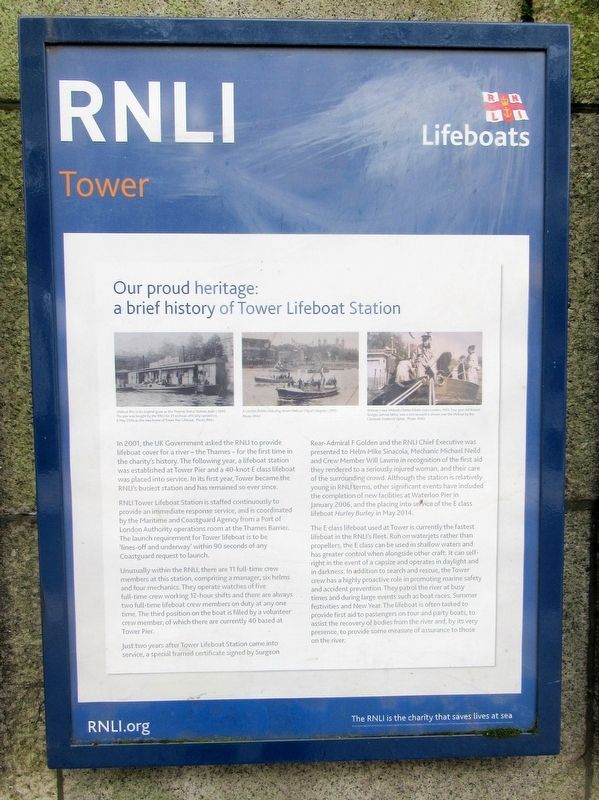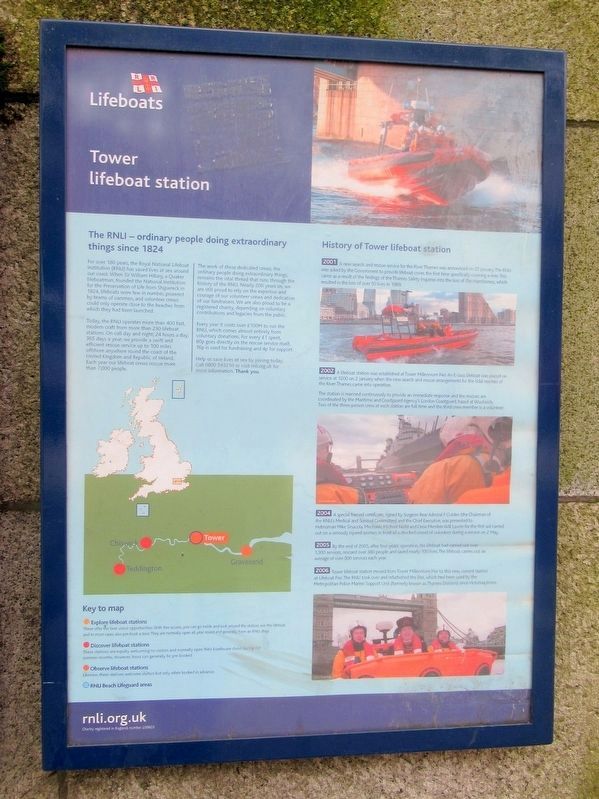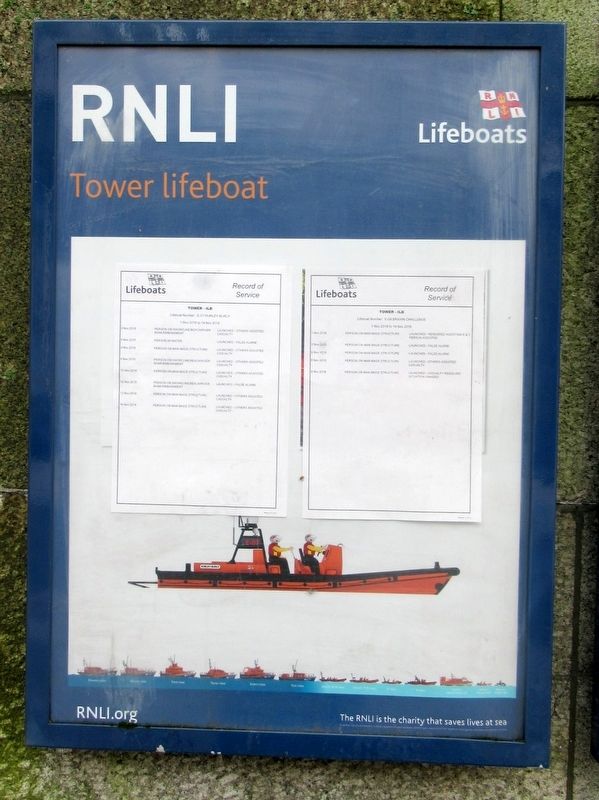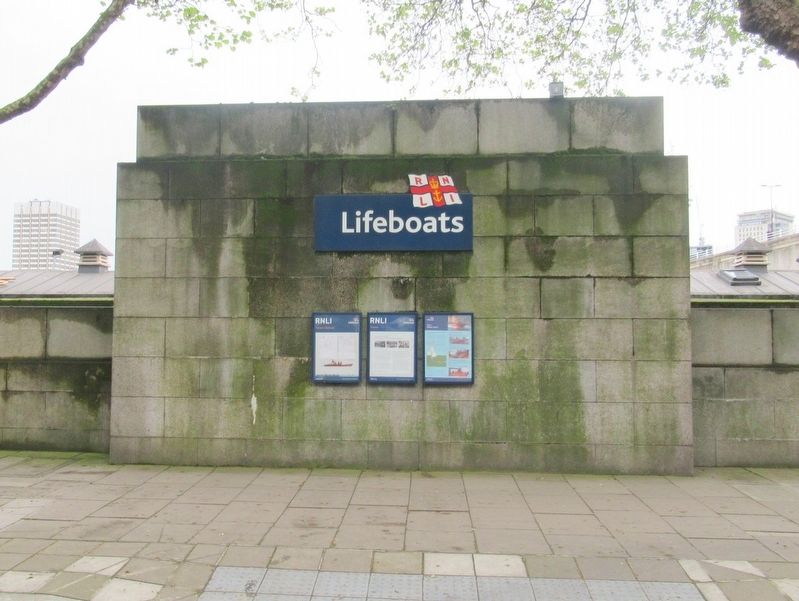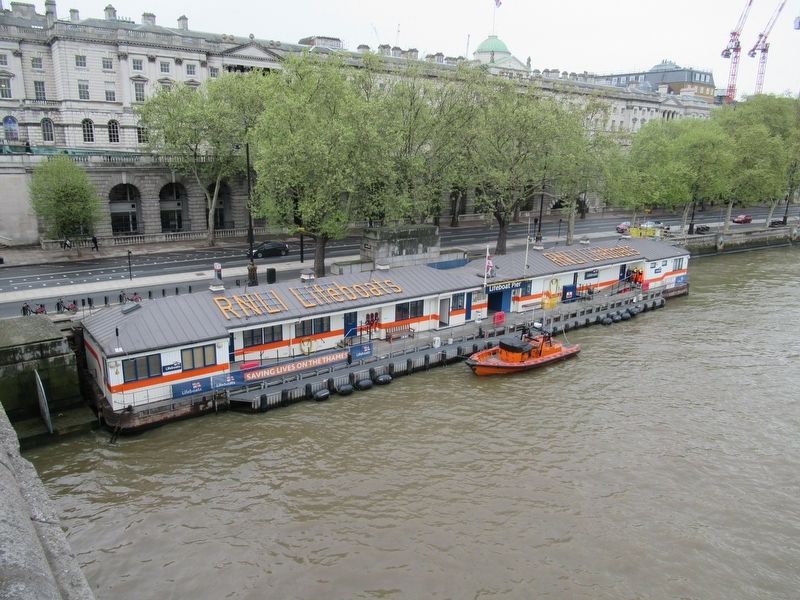City of Westminster in Greater London, England, United Kingdom — Northwestern Europe (the British Isles)
RNLI Tower Lifeboat Station
In 2001, the UK Government asked the RNLI to provide lifeboat cover for a river - the Thames - for the first time in the charity's history. The following year, a lifeboat station was established at Tower Pier and a 40-knot E class lifeboat was placed into service. In its first year, Tower became the RNLI's busiest station and has remained so ever since.
RNLI Tower Lifeboat Station is staffed continuously to provide an immediate response service, and is coordinated by the Maritime and Coastguard Agency from a Port of London Authority operations room at the Thames Barrier. The launch requirement for Tower lifeboat is to be ‘lines-off and underway' within 90 seconds of any Coastguard request to launch.
Unusually within the RNLI, there are 11 full-time crew members at this station, comprising a manager, six helms and four mechanics. They operate watches of five full-time crew working 12-hour shifts and there are always two full-time lifeboat crew members on duty at any one time. The third position on the boat is filled by a volunteer crew member, of which there are currently 40 based at Tower Pier.
Just two years after Tower Lifeboat Station came into service, a special framed certificate signed by Surgeon Rear-Admiral F Golden and the RNLI Chief Executive was presented to Helm Mike Sinacola, Mechanic Michael Neild and Crew Member Will Lawrie in recognition of the first aid they rendered to a seriously injured woman, and their care of the surrounding crowd. Although the station is relatively young in RNLI terms, other significant events have included the completion of new facilities at Waterloo Pier in January 2006, and the placing into service of the E class lifeboat Hurley Burley in May 2014.
The E class lifeboat used at Tower is currently the fastest lifeboat in the RNLI's fleet. Run on waterjets rather than propellers, the E class can be used in shallow waters and has greater control when alongside other craft. It can self- right in the event of a capsize and operates in daylight and in darkness. In addition to search and rescue, the Tower crew has a highly proactive role in promoting marine safety and accident prevention. They patrol the river at busy times and during large events such as boat races, Summer festivities and New Year. The lifeboat is often tasked to provide first aid to passengers on tour and party boats, to assist the recovery of bodies from the river and, by its very presence, to provide some measure of assurance to those on the river.
( right panel )
For over 180 years, the Royal National Lifeboat Institution (RNLI) has saved lives at sea around our coast. When Sir William Hillary, a Quaker lifeboatman, founded the National Institution for the Preservation of Life from Shipwreck in 1824, lifeboats were few in number, powered by teams of oarsmen, and volunteer crews could only operate close to the beaches from which they had been launched.
Today, the RNLI operates more than 400 fast, modern craft from more than 230 lifeboat stations. On call day and night; 24 hours a day; 365 days a year, we provide a swift and efficient rescue service up to 100 miles offshore anywhere round the coast of the United Kingdom and Republic of Ireland Each year our lifeboat crews rescue more than 7,000 people.
The work of these dedicated crews, the ordinary people doing extraordinary things, remains the vital thread that runs through the history of the RNLI. Nearly 200 years on, we are still proud to rely on the expertise and courage of our volunteer crews and dedication of our fundraisers. We are also proud to be a registered charity, depending on voluntary contributions and legacies from the public.
Every year it costs over £100M to run the RNLI, which comes almost entirely from voluntary donations. For every £1 spent, 80p goes directly on the rescue service itself 16p is used for fundraising and 4p for support.
Help us save lives at sea by joining today. Call xxxx xxxxxx or visit mli.org.uk for more information. Thank you.
History of Tower lifeboat
station
2001 A new search and rescue service for the River Thames was announced on 22 january The RNU was asked by the Govemment to provide lifeboat cover, the first time specifically covering a river. This carne as a result of the findings of the Thames Safety Inquiries into the loss of The Marchioness , which resulted in the loss of over 50 lives in 1989.
2002 A lifeboat station was established at Tower Millennium Pier. An E class lifeboat was placed on service at 1200 on 2 January when the new search and rescue arrangements for the tidal reaches of the River Thames came into operation.
The station is manned continuously to provide an immediate response and the rescues are coordinated by the Maritime and Coastguard Agency's London Coastguard, based at Woolwich. Two of the three-person crew at each station are full time and the third crew member is a volunteer.
2004A special framed certificate, signed by Surgeon Rear Admiral F Golden (the Chaiman of the RNLU's Medical and Survival Committee) and the Chief Executive, was presented to Helmsman Mike Sinacola, Mechanic Michael Neild and Crew Member Will Lawrie for the first aid carried out on a seriously injured woman in front of a shocked crowd of onlookers during a service on 2 May.
2005 By the end of 2005, after four years operation, the lifeboat had carried out 1,300 services, rescued over 380 people and saved nearly 100 lives The lifeboat cames out an average of over 300 services each year.
2006 Tower lifeboat station moved from Tower Millennium Pier to this new, current station at Lifeboat Pier. The RNLI took over and refurbished the Pier, which hed been used by the Metropolitan Police Marine Support Unit (formerly known as Thames Division) since Victonian times.
Topics. This historical marker is listed in this topic list: Waterways & Vessels.
Location. 51° 30.602′ N, 0° 7.041′ W. Marker is in City of Westminster, England, in Greater London. Marker is at the intersection of Victoria Embankment and Savoy Street, on the right when traveling north on Victoria Embankment. Located in front of Lifeboat Pier, Victoria Embankment, next to Waterloo Bridge. Touch for map. Marker is in this post office area: City of Westminster, England WC2R 2PP, United Kingdom. Touch for directions.
Other nearby markers. At least 8 other markers are within walking distance of this marker. Sir Walter Besant (within shouting distance of this marker); Foundation Stone (about 120 meters away, measured in a direct line); British Broadcasting Company Studios (about 150 meters away); Isambard Kingdom Brunel (about 150 meters away); The Yacht London (about 210 meters away); The Wellington (about 210 meters away); Robert Raikes (about 210 meters away); Gaiety Theatre (about 210 meters away). Touch for a list and map of all markers in City of Westminster.
Also see . . .
1. Royal National Lifeboat Institution (RNLI). (Submitted on May 30, 2018, by Michael Herrick of Southbury, Connecticut.)
2. Royal National Lifeboat Institution on Wikipedia. (Submitted on May 30, 2018, by Michael Herrick of Southbury, Connecticut.)
3. Tower Lifeboat Station on Wikipedia. (Submitted on May 30, 2018, by Michael Herrick of Southbury, Connecticut.)
Credits. This page was last revised on January 27, 2022. It was originally submitted on May 30, 2018, by Michael Herrick of Southbury, Connecticut. This page has been viewed 231 times since then and 23 times this year. Photos: 1, 2, 3, 4, 5. submitted on May 30, 2018, by Michael Herrick of Southbury, Connecticut.
